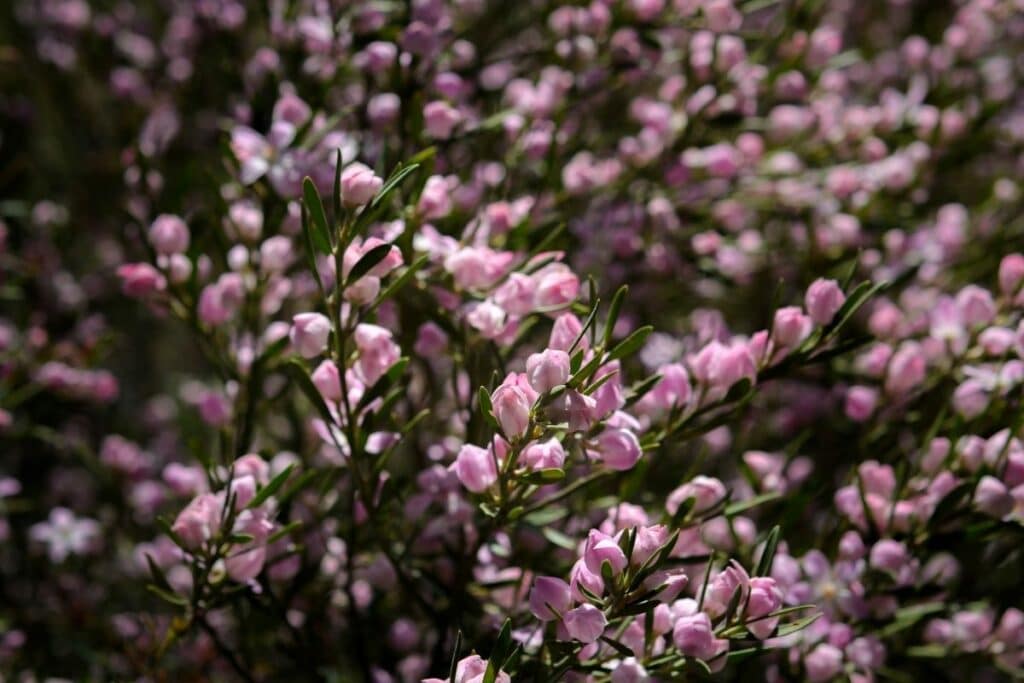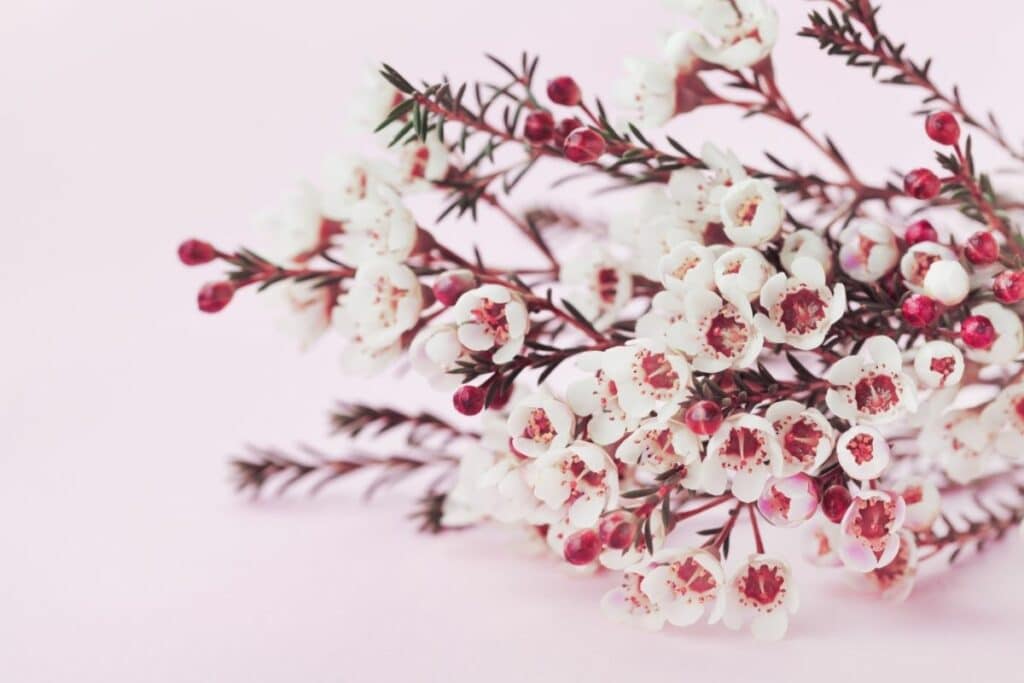Flower Glossary is reader-supported. When you buy through links on our site, we may earn an affiliate commission.
Waxflower plants have become an increasingly popular variety of plants, and it’s not hard to see why!
Their gorgeously delicate, romantic, and colorful blooms make them perfect for decorative arrangements and are certain to brighten up any garden or interior.
To learn more about Waxflowers, take a look at our ultimate guide. We include everything, from the most popular varieties of Waxflowers to how to successfully grow them.

We also discuss popular uses of the Waxplant in the hope that we will inspire you to incorporate these gorgeous blooms into your life.
Take a look below!
Table of Contents
Chamelaucium Waxflower Info
Chamelaucium is a genus of flowering plants in the family Asteraceae (Compositae).
It contains about 30 species native to Australia, New Zealand, South America, Africa, Madagascar, India, and Asia.
The name comes from the French chamaélée meaning “wax flower”, referring to the waxy feel of the petals.
Common Types Of Waxflower
The most common waxflower is Geraldton Wax or Chamelaucium Uncinatum.
This is the most cultivated variety of Waxflower and it has been widely used as an ornamental plant for many years. Other common varieties are:
Esperance
The Esperance Waxflower is a perennial plant that blooms all throughout the summer. It reaches heights of seven feet tall.
It produces the most beautiful pink, red, and white blossoms.
Brevifolium
This type of Waxflower is endemic to Australia. This plant grows up to 4 feet tall, making it one of the smallest Chamelaucium varieties.
It produces white flowers, which are very strong smelling.
Matilda
The Chamelaucium ‘Matilda’ is a particularly pretty plant. This is a small shrub that can grow anywhere from 2 to 4 feet tall. It has light green leaves, and its flowers turn from white to deep red-pink color.
Ciliatum
The variety of waxflower is not picky about its environment at all. It can grow in most soils, including rockier soils. It produces wonderful white flowers.
Bridal Pearl
This is a new hybrid variety of Waxplant. This type has wonderfully delicate white blooms. They also tend to last longer than other varieties once cut, making them perfect for bouquets.
Drummondii
This plant looks like something out of a storybook. It grows up to four feet high and produces beautiful pink flowers.
It is a very unique-looking plant, consisting of a variety of interesting shapes and colors.
How To Grow Waxflower
If the information above has convinced you to get a variety of Waxflower, we don’t blame you! These plants are truly beautiful and brighten up any space.
However, it is important that you understand exactly how to care for your Waxflower to ensure longevity.
Check out the information below to ensure that you give your plant the environment it needs to thrive!
Soil Needs
Waxplants will thrive in particularly sandy soil. Poorly drained soils need to be amended with organic matter. For instance, adding gritty matter to such soil will enhance percolation.
Sun Exposure
This flower tends to thrive in dry climates. However, they are quite hardy and have been known to do well throughout the winter too.
For the best results, place this plant in direct sunlight, but keep an eye on the temperature. If it is too hot, it will need to be watered thoroughly and regularly.
Watering And Fertilizer
Wax flowers grow well in dry soil. They need low levels of water once established unless the environment is too hot (as described above).
They do not need much fertilizer. If you want to fertilize your Waxflower, we recommend using a slow-release fertilizer when you initially plant it, and then once a year each Spring.
Pest And Disease Prevention
Generally speaking, the Waxflower is pretty resistant to most pests and diseases. However, it is important to keep an eye out for common infestations such as mealy bugs.
These can be identified by their oval shape and body segmentation.
Mealybugs will result in the leaves of your plant drooping and turning yellow. If you notice an infestation, you should wipe the mealybugs away using an alcohol-soaked cotton bud.
Then carefully spray the leaves with a concoction made up of 1 cup of rubbing alcohol, a few drops of dish soap, and 32 oz of water.
Another thing to be aware of when it comes to the Waxflower is the possibility of root rot. As previously mentioned, this plant requires well-draining soil.
If it is allowed to sit in water for too long, there is a strong chance that root rot could take hold.
If your plant has stopped growing or is wilting considerably, there is a chance that it is experiencing root rot.
As such, it is very important to ensure that the soil of your plant is appropriate and that you don’t overwater it, because root rot can quickly lead to death.
Uses For Wax Flower Chamelaucium

Wax flowers make for a great garden or house ornamental plant.
However, they also tend to be used in different types of floral arrangements for various occasions. Take a look at the most common uses for wax flowers below.
Waxplant Floral Crowns
In recent years, floral crowns have become quite popular. Wax flowers make for a beautiful addition to a flower crown.
They are simple, delicate, not overpowering, and budget-friendly!
Wedding Bouquets
The waxflower symbolizes rich, patient, and long-lasting love, so it is most commonly cut and used in wedding bouquets. Their subtle nature adds an elegant feel to floral bouquets.
Table Arrangements
Waxplants make for a glorious addition to table arrangements.
Whether it’s a simple centerpiece at an understated wedding or a charming decorative flower arrangement for a family get-together, Waxplants work wonderfully.
Final Thoughts
Waxplants produce some of the most beautiful blooms. There are a huge number of waxplant varieties, each one with its own colorway and scent.
We hope that this article has inspired you to grow a waxplant, or even to incorporate them as cut flowers into your decor.
